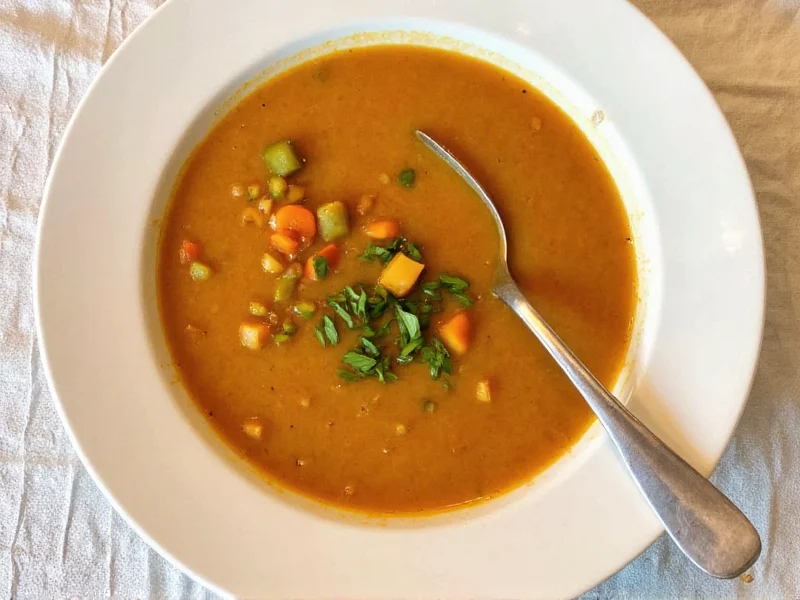The perfect easy veggie soup balances simplicity with robust flavor, requiring minimal prep time while delivering maximum nutritional benefits. This straightforward vegetable soup recipe creates a satisfying meal that's naturally vegan, gluten-free, and packed with vitamins. Whether you're a cooking novice or need a quick weeknight dinner solution, this approachable method transforms basic ingredients into a comforting dish that can be customized to suit any dietary preference.
Essential Ingredients for Simple Vegetable Soup
Creating an easy vegetable soup starts with selecting the right combination of fresh produce and pantry staples. The beauty of this recipe lies in its flexibility—most ingredients can be substituted based on what's available in your kitchen. For the best results with minimal effort, focus on these foundational components:
| Category | Essential Items | Prep Time |
|---|---|---|
| Aromatics | 1 onion, 2 carrots, 2 celery stalks, 3 garlic cloves | 5 minutes |
| Vegetables | 4 cups mixed vegetables (zucchini, bell peppers, green beans) | 3 minutes |
| Liquid Base | 4 cups vegetable broth (low sodium) | 0 minutes |
| Seasonings | 1 tsp dried thyme, 2 bay leaves, salt, pepper | 1 minute |
| Finishing Touches | Fresh parsley, lemon juice, optional protein | 1 minute |
Step-by-Step Easy Vegetable Soup Recipe
Follow these simple steps for a foolproof veggie soup that consistently delivers delicious results. This method minimizes active cooking time while maximizing flavor development through smart technique.
Preparation (10 minutes)
Begin by washing and roughly chopping your vegetables. The key to easy vegetable soup is uniform sizing—cut everything into similar 1-inch pieces for even cooking. You don't need precision knife skills; rustic chunks actually enhance the homemade quality. Keep aromatics (onion, carrots, celery) separate from other vegetables as they'll be cooked first to build flavor.
Cooking Process (20 minutes)
- Sauté aromatics: Heat 1 tablespoon olive oil in a large pot over medium heat. Add onions, carrots, and celery with a pinch of salt. Cook for 5-7 minutes until softened but not browned.
- Add garlic: Stir in minced garlic and cook for 30 seconds until fragrant—be careful not to burn it.
- Incorporate vegetables: Add your mixed vegetables and dried herbs, stirring to coat everything with the aromatic base.
- Pour in broth: Add vegetable broth and bay leaves, bringing the mixture to a gentle boil.
- Simmer: Reduce heat to low, cover partially, and simmer for 15 minutes until vegetables are tender but still vibrant.
- Finish: Remove bay leaves, stir in fresh parsley and a squeeze of lemon juice for brightness.
Why This Easy Veggie Soup Recipe Works
The secret to exceptional easy vegetable soup lies in understanding flavor development with minimal effort. Unlike complicated recipes requiring multiple techniques, this approach leverages three fundamental principles that create depth without extra work:
First, the layered cooking method builds flavor gradually—starting with aromatics creates a flavor foundation that infuses the entire soup. Second, the acid finish (lemon juice or vinegar) added at the end brightens flavors and makes ingredients taste fresher. Third, the strategic vegetable timing ensures each component cooks perfectly—harder vegetables go in first, delicate ones later.
Customization Options for Your Vegetable Soup
One reason this easy vegetable soup recipe has remained popular for generations is its incredible adaptability. Consider these simple variations to suit different preferences and dietary needs:
- Protein boost: Add canned white beans, lentils, or chickpeas during the last 5 minutes of cooking for extra protein
- Creamy version: Blend half the soup for a thicker texture, or stir in coconut milk for richness
- Seasonal adaptations: Use butternut squash in fall, asparagus in spring, or tomatoes in summer
- Spice variations: Add red pepper flakes for heat or curry powder for an international twist
Storage and Reheating Tips
This easy vegetable soup actually improves in flavor after sitting, making it perfect for meal prep. Store cooled soup in airtight containers for up to 5 days in the refrigerator or freeze portions for up to 3 months. When reheating, add a splash of water or broth as vegetables absorb liquid during storage. For best results, gently warm on the stove over medium-low heat rather than boiling vigorously, which can overcook the vegetables.
Nutritional Benefits of Homemade Veggie Soup
Unlike store-bought versions that often contain excessive sodium and preservatives, this easy vegetable soup recipe delivers genuine nutritional advantages. A single serving provides approximately 150-200 calories, packed with fiber, vitamins A and C, and various antioxidants. The combination of different colored vegetables ensures a broad spectrum of phytonutrients. For maximum nutrient retention, avoid overcooking and add delicate greens like spinach during the final minutes of preparation.
Troubleshooting Common Veggie Soup Issues
Even the simplest easy vegetable soup recipes can encounter minor issues. Here's how to address the most frequent problems:
- Soup too watery: Simmer uncovered for 5-10 minutes to reduce liquid, or blend a portion of the vegetables to thicken
- Flavor too bland: Add salt in small increments while cooking, or finish with acid (lemon juice/vinegar) to enhance existing flavors
- Vegetables overcooked: Add harder vegetables first and delicate ones later in the cooking process
- Too much salt: Add a peeled potato to absorb excess salt, or dilute with additional unsalted broth











 浙公网安备
33010002000092号
浙公网安备
33010002000092号 浙B2-20120091-4
浙B2-20120091-4